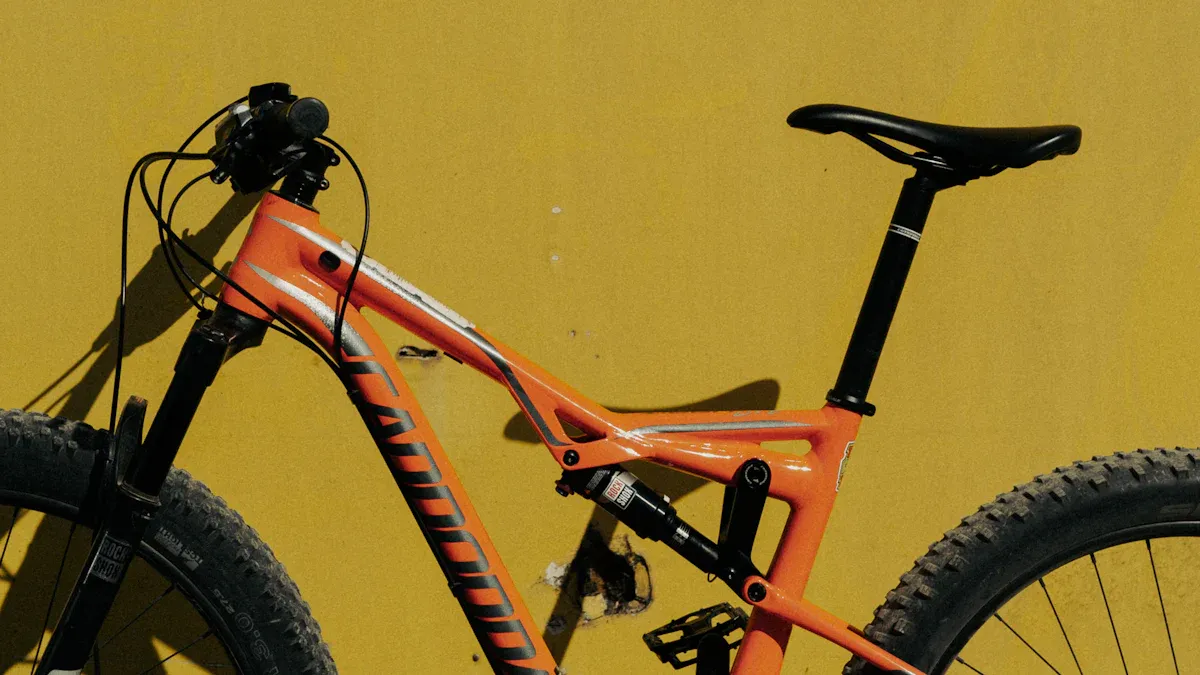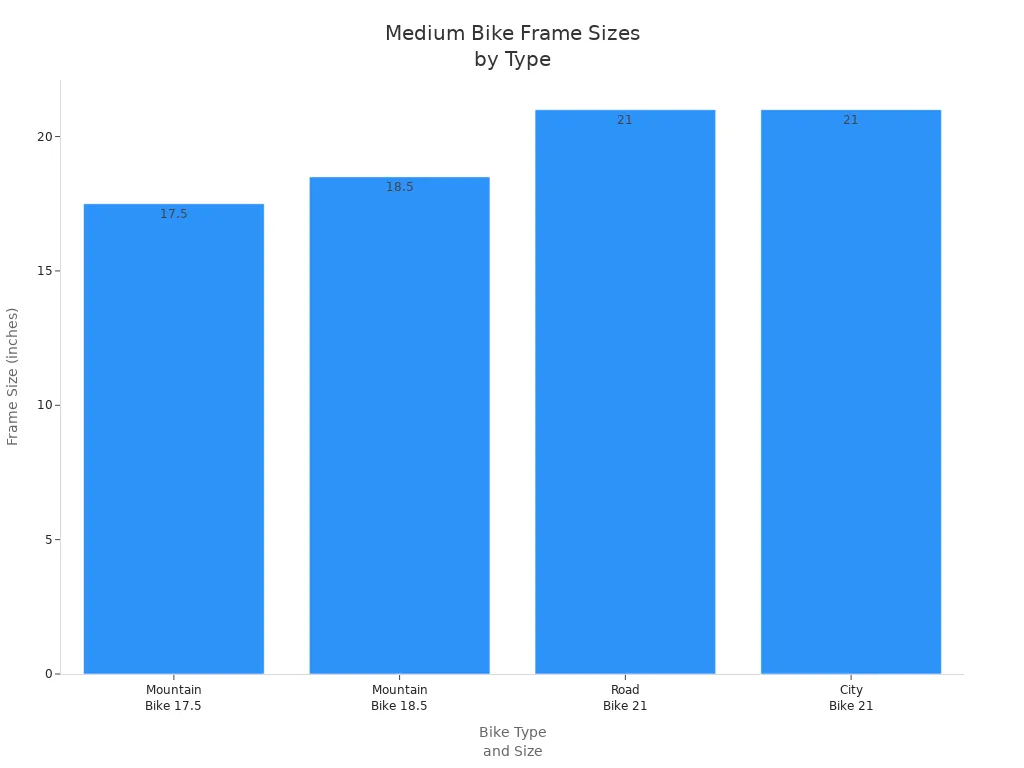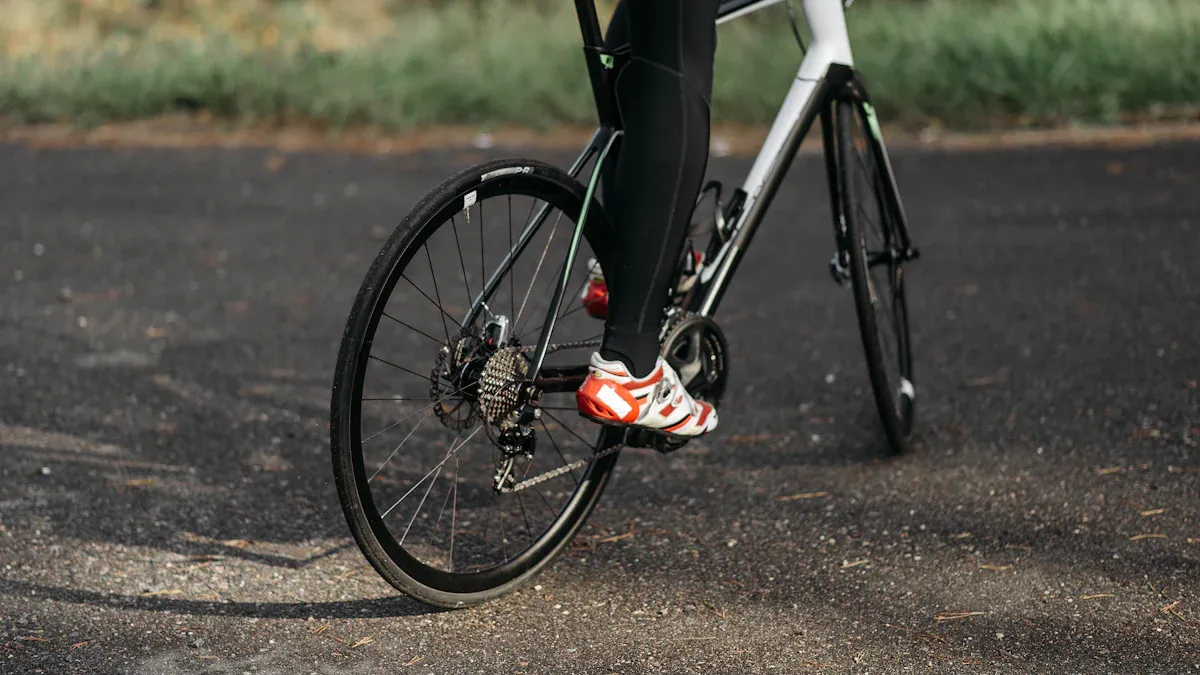
Choosing a medium size bike frame starts with knowing your height and inseam. You want to grab a tape measure and check both numbers before you look at any bikes. Use the right formula for your bike type, since road and mountain bikes need different math. Comfort matters a lot here. Studies show that the right frame size helps your body absorb bumps and keeps you safe, especially when the frame fits your posture. Always take a test ride if you can. The bike sizing guide is your best friend for finding the perfect fit.
Key Takeaways
Measure your height, inseam, and arm span carefully to find the right medium bike frame size.
Use bike size charts and inseam-based formulas for different bike types to choose the best fit.
Test ride bikes to check comfort, reach, and standover height before buying.
If you fall between sizes, pick smaller for sportier rides or larger for more comfort.
Seek expert help from local shops or professional fitters for a personalized bike fit.
Medium Size Bike Frame Basics
Who Needs Medium Size?
You might wonder if a medium size bike frame is right for you. Most riders who stand between 5’3″ and 5’11” (160–180 cm) and have an inseam between 29″ and 32″ (74–81 cm) fit into this category. If your body height or inseam falls in these ranges, you probably need a medium frame. This size works well for many adults, especially if you want a balance between comfort and control. Riders who like a mix of speed and stability often choose medium frames. If you check a bike size chart, you will see that medium frames cover a wide range of adult bike sizing needs.
Here’s a quick look at how different bike types define medium frames:
Bike Type | Rider Height Range | Leg Inseam Range | Medium Frame Size (cm) | Medium Frame Size (inches) |
|---|---|---|---|---|
Mountain Bike | 170 – 180 cm | 72 – 77 cm | 42 – 44 cm | 16.5 – 17.3 in |
Mountain Bike | 175 – 185 cm | 77 – 81 cm | 45 – 46 cm | 17.7 – 18.1 in |
Road Bike | 5’3″ – 5’8″ (160 – 173 cm) | 29.3″ – 30.7″ (74.4 – 78 cm) | ~53 cm | 21 in |
City Bike | 5’5″ – 5’11” (165 – 180 cm) | 30.1″ – 31.6″ (76.5 – 80.3 cm) | ~53 cm | 21 in |

Key Measurements
To find your best bike frame size, you need three main numbers: height, inseam, and arm span. Start by measuring your body height. Stand straight against a wall and use a tape measure from the floor to the top of your head. Next, measure your inseam. Stand with your feet about 6 inches apart and measure from the floor up to your crotch. This number helps you match your legs to the frame.
Don’t forget your arm span. Stretch your arms out wide and measure from fingertip to fingertip. If your arm span is longer than your height, you may need a slightly larger frame for a better fit. If your arms are shorter, a smaller frame might feel more comfortable. This tip helps you get the right reach and keeps your ride smooth.
Tip: Always double-check your measurements before picking a frame. A good fit makes every ride safer and more fun.
You can use these numbers with a bike size chart or sizing formula. For example, for road bikes, multiply your inseam by 0.7 to estimate the frame size in centimeters. For mountain bikes, use inseam times 0.58. These steps help you find the perfect medium size bike frame for your needs.
Measure Yourself

Getting the right fit starts with knowing your body height, inseam, and arm span. These numbers help you find a bike frame that feels just right. Let’s break down how you can measure each one at home.
Height and Inseam
You want to start with your body height. Stand straight against a wall with your shoes off. Ask a friend to help for the best results. Mark the top of your head on the wall, then use a tape measure from the floor to the mark. Write down your height.
Now, measure your inseam. Stand with your feet shoulder-width apart. Place a book between your legs, pressing it up like a bike seat. Measure from the floor to the top of the book. This is your inseam. Make sure you wear snug clothes and stand tall. Don’t wear shoes, and check that the book is level. Repeat the measurement a couple of times to be sure you get the same number.
Tip: Small mistakes in measuring height and inseam can lead to a poor fit. Even half an inch can make a big difference in comfort.
Here are some tools and tips that make measuring easier:
Use a tape measure and a sturdy book.
Ask someone to help for better accuracy.
Try online fit calculators like the Wrench Science Fit System or the Specialized / Retül app for extra guidance.
Arm Span
Stretch your arms out wide, parallel to the floor. Have a friend measure from the tip of one middle finger to the other. This is your arm span. Compare this number to your body height. If your arm span is longer, you might need a bigger frame for a better fit. If it’s shorter, a smaller frame could work best.
You can also figure out your Ape Index by subtracting your height from your arm span. This helps you decide if you should size up or down, especially if you fall between sizes. If you still feel the reach isn’t perfect, you can adjust the bike stem later.
Bike Size Guide
Sizing Charts
When you look for a medium size bike frame, you want to start with bike size charts. These charts help you match your height and inseam to the right bike frame size. Most bike shops and brands use these charts to guide you. You will see that each bike type—road, mountain, hybrid, and gravel—has its own sizing system.
Here’s a table that shows how bike size charts work for different bikes:
Bike Type | Rider Height Range | Recommended Frame Size |
|---|---|---|
Gravel (similar to Road) | 4’10” – 5’0″ | 47-49 cm (XS) |
Gravel (similar to Road) | 5’0″ – 5’3″ | 49-50 cm (SM) |
Gravel (similar to Road) | 5’3″ – 5’6″ | 50-54 cm (MD) |
Gravel (similar to Road) | 5’6″ – 5’9″ | 54-56 cm (M/L) |
Gravel (similar to Road) | 5’9″ – 6’0″ | 56-58 cm (L) |
Gravel (similar to Road) | 6’0″ – 6’4″ | 58-63 cm (XL/XXL) |
Hybrid | 4’10” – 5’1″ | 14″ or XS to S |
Hybrid | 5’1″ – 5’5″ | 16″ or S to M |
Hybrid | 5’5″ – 5’9″ | 18″ or M to M/L |
Hybrid | 5’9″ – 6’0″ | 19″ or L |
Hybrid | 6’0″ – 6’3″ | 20″ or XL |
Hybrid | 6’1″ – 6’6″ | 22″ or XXL |
Bike size charts from trusted shops like The Bike Shoppe use both height and inseam. You will notice that some brands use centimeters, while others use inches or XS-XL labels. Road bike sizing usually goes by seat tube length in centimeters. Mountain bike sizing often uses inches or small, medium, and large. Hybrid bikes mix both systems.
Tip: Always check the bike size chart for your chosen brand. Each company may use a slightly different system, so you want to be sure you get the right fit.
Some brands recommend sizing up if you have long arms or legs. Others suggest sizing down if you prefer a more upright position. Mountain bike sizing can change a lot between brands because frame geometry keeps evolving. You should always look at the chart and compare your measurements.
Inseam Formulas
You want to measure your inseam for the most accurate bike frame size. Experts say inseam-based formulas work better than height alone, especially for medium size bike frames. Your inseam tells you how much leg room you need, which makes your ride smoother and safer.
Here are the most common formulas you can use with your bike size chart:
Road Bikes:
Frame Size (cm) = inseam (cm) × 0.665
This formula gives you a good starting point for road bike sizing. If you have longer arms, you might want to size up for extra reach.Mountain Bikes:
Frame Size (inches) = inseam (cm) × 0.225
Mountain bike sizing uses this formula to match your leg length to the frame. Some brands use small, medium, and large instead of numbers, so check the bike size chart.Hybrid Bikes:
Frame Size (cm) = inseam (cm) × 0.685
Hybrid bikes use a formula close to road bikes. You get a comfortable fit for city riding or casual trips.Trekking Bikes:
Frame Size (cm) = inseam (cm) × 0.66
Trekking bikes need a little extra room for longer rides.
Note: Measure your inseam carefully. Stand tall, use a book, and repeat the measurement to make sure it’s right. Even a small mistake can change your bike frame size.
Bike size charts and inseam formulas work best together. You want to use both your height and inseam, then check the chart for your bike type. If you fall between sizes, think about your riding style. Do you want more speed or more comfort? Your arm span and torso length also matter, so don’t forget those numbers.
Many riders find that inseam-based sizing gives them a better fit, especially for medium size bike frames. You get more control and less strain on your knees. Still, no single method is perfect. Try to use the bike size guide, measure your inseam, and check the bike size chart for your favorite brand. If you feel unsure, ask for help at your local shop or use an online calculator.
🚲 Quick Recap:
Use bike size charts for your bike type.
Measure your inseam for the best frame size.
Check formulas for road, mountain, hybrid, and trekking bikes.
Always compare your numbers to the chart.
Comfort and safety come first!
What Size Bike Should I Get?
Choosing the right bike size can feel tricky, especially if you find yourself between two frame sizes or have unique body proportions. Let’s break down what you should do in these situations so you can ride with confidence and comfort.
Between Sizes
Sometimes, you measure yourself and land right between two bike frame sizes. Don’t worry—this happens to lots of riders! Here’s how you can decide which way to go:
Look at your inseam and height first. These are the main numbers that help you choose the right bike size.
If you want a more active, sporty ride, pick the smaller frame. Smaller frames make it easier to move quickly and handle sharp turns.
If you care more about comfort, try the larger frame. Bigger frames give you a more relaxed position and can feel better on long rides.
Always test ride both sizes if you can. The way a bike feels is personal, and only you know what feels right.
Check the bike brand’s recommendations. Each company designs bikes for certain rider profiles, so their advice matters.
These tips work for all types of bikes—road, city, and mountain.
Tip: There’s no perfect answer to “what size bike should I get” when you’re between sizes. Think about your riding style and comfort. Try both options if possible.
If you have long arms or legs, pay extra attention to your inseam and upper body length. Long legs mean you should focus on inseam, but also check how far you have to reach for the handlebars. Sometimes, you might need a smaller frame for your upper body, even if your height suggests a bigger one. You can adjust the seat and stem to fine-tune the fit, but the frame size sets the foundation for comfort.
Special Needs
Not everyone fits the “average” rider profile. Maybe you have longer arms, a shorter torso, or other unique body features. Here’s how you can choose the right bike size for your needs:
Measure your Rider-Area Distance (RAD). Stand like you’re on a bike, hands at bar width, and measure from the ground to your first knuckle while making a fist.
Compare your RAD to the bike’s RAD. A RAD-neutral fit helps you get the most power, control, and comfort.
Focus on the bike’s frame reach. This is the distance from the bottom bracket to the top of the head tube. Don’t just look at height-based sizing.
Aim for a frame reach that’s in the middle or shorter end of the suggested range. This usually means multiplying your height in centimeters by 2.4 to 2.5.
Avoid a frame reach that’s too long. If the reach is too much, you might lose power, feel uncomfortable, or even risk injury.
If you have unique proportions, consider a professional bike fitting. Experts can help you choose the right bike and set it up just for you.
Some bikes come in gender-specific frames. These frames often have different shapes or sizes to fit men’s and women’s bodies better. If you have a smaller torso or longer legs, a gender-specific frame might help you get the right bike size. Always check if the brand offers these options.
Note: The right bike size is about more than just numbers. Your comfort, safety, and riding style matter most. Don’t be afraid to ask for help or try different setups until you find what feels best.
When you choose the right bike size, you set yourself up for a fun and safe ride. Remember, the right bike lets you ride longer, faster, and with less pain. Take your time, measure carefully, and don’t settle for a bike that doesn’t feel just right.
Figure Out Your Bike Size in Person
Standover Height
When you figure out your bike size, standover height is the first thing to check. Stand over the bike with both feet flat on the ground. You want at least an inch of space between the top tube and your groin. This gap keeps you safe if you need to hop off quickly. If there’s no clearance, the frame is too big. If there’s too much space, the frame might be too small. Standover height helps you get a proper bike fit and prevents injuries. Always check this before you test ride the bike.
Tip: Standover height is a simple way to know how to check if a bike is the right size. It’s quick and easy, but it makes a big difference for comfort and safety.
Reach and Comfort
Reach is the distance from the seat to the handlebars. This measurement affects how you sit and control the bike. If the reach is too short, you feel cramped and your knees or lower back may hurt. If the reach is too long, you stretch too much and your neck, shoulders, or wrists get sore. The right reach gives you a comfortable riding experience and better control. A longer reach can make you feel stable at high speeds, while a shorter reach helps you handle tight turns. You want to find the perfect bike fit by balancing comfort and control. Try adjusting the seat and handlebars during fitting to see what feels best.
Test Ride
You should always test ride the bike before you buy it. This is the best way to figure out your bike size and see if the fit works for you. During your test ride, pay attention to these things:
Standover height: Make sure you have enough clearance.
Leg extension: Your knee should bend about 15-20° at the bottom of the pedal stroke.
Reach: Notice how far you stretch to grab the handlebars.
Riding style: Think about whether you want a sporty or relaxed position.
A good fitting means you feel comfortable, safe, and in control. If something feels off, try another size or adjust the bike. The goal is to get a fit that matches your body and riding style. When you test ride the bike, you can spot problems before you buy. This helps you get the perfect bike fit for every ride.
🚲 Remember: Comfort and safety matter most. Take your time with fitting and test ride the bike until you find the right match.
Expert Help

Professional Fitting
Sometimes, you just want to get your bike fitting right the first time. That’s when you should think about a professional fitting. A pro fitter looks at more than just your height and inseam. They know that every body is different. Your spine can even change a little during the day! Fitters use special tools like laser systems or sizing cycles to measure your body. They check your torso, arm length, shoulder width, and even your ape index.
During a bike fitting, the expert will ask about your riding style and goals. They look at how flexible you are and if you have any injuries. The fitting starts with picking the best frame size for you. Then, the fitter adjusts the seat, handlebars, and pedals. They want your feet, pelvis, and hands to feel just right. This process helps you avoid pain and makes your ride smoother. You might be surprised—two people with the same height can need different frame sizes. That’s why a personalized fitting matters so much.
Online bike fitting tools can help, too. Some apps and websites give you a good starting point. They use your measurements to suggest a frame size and saddle height. These tools work well for medium size frames and can get you close to the perfect fit. But they can’t check your flexibility or riding style. Only a real fitting can do that.
Local Bike Shops
Your local bike shop is a great place for help with bike fitting. The staff knows how to match you with the right bike style and size. They help you pick a medium size frame that fits your needs. You can get this help when you rent or buy a bike. The staff will answer your questions and guide you through the fitting process.
Most shops offer more than just bike fitting. They can fix your bike and sometimes offer payment plans. But the best part is the expert advice. You get to talk to someone who understands fitting and wants you to ride safely and comfortably. If you ever feel unsure about your bike fitting, just ask for help at your local shop.
Tip: Start with online tools for a quick fit, but visit a shop or fitter for the best bike fitting experience. Your comfort and safety come first!
Getting the right medium bike frame starts with measuring your inseam and checking the size guide. This step helps you avoid pain and keeps you safe on every ride. Test rides matter, too—they let you feel the fit and make sure the bike matches your style. If you ever feel unsure, ask an expert at your local shop. Remember, a bike that fits well means more comfort, fewer injuries, and a lot more fun on the road or trail. 🚴♂️
FAQ
How do I know if a medium bike frame is right for me?
Check your height and inseam. If you stand between 5’3″ and 5’11” and your inseam falls between 29″ and 32″, a medium frame likely fits you. Always test ride to confirm.
Can I adjust a medium frame if it feels a bit off?
Yes, you can tweak the seat height, handlebar position, and stem length. Small changes make a big difference. If you still feel uncomfortable, try another frame size.
What happens if I pick the wrong bike frame size?
You might feel pain in your knees, back, or wrists. Riding could feel awkward or unsafe. The right size helps you ride longer and enjoy every trip.
Should I use my height or inseam to choose a bike frame?
Use both. Your inseam gives a more accurate fit, especially for leg comfort. Height helps, but inseam measurements match your body to the bike better.
Is it okay to buy a bike online without trying it first?
You can, but it’s risky. Always check the sizing chart and measure yourself carefully. If possible, visit a local shop for a test ride before you buy.
See Also
Selecting The Perfect Bike Frame To Suit Your Needs
Understanding Racing Bike Frame Sizes For All Riders
Key Factors To Find The Ideal Bike Frame Fit
